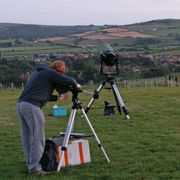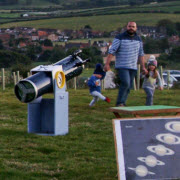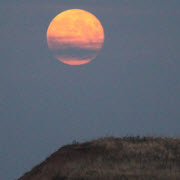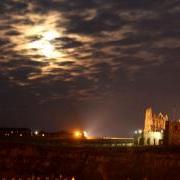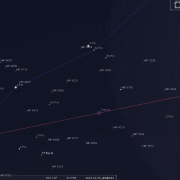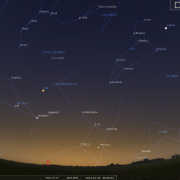Welcome to the WDAS monthly newsletter for October 2014: a digest of the month's latest contributions to our website. Below you'll find Society News, Sky Notes and In-Focus articles printed in full. There's also future events, and trailers for other articles which appear in full on the website - just a click away!
On the website you'll also be able to comment on articles, and if you'd like to play an editorial role in creating new content, just let us know!
If you don't see images in this e-mail, look for a setting in your browser or e-mail reader to display them; and if you have any other problems reading the newsletter please let us know the browser or e-mail program you're using, and we'll see if we can fix it.
Society News
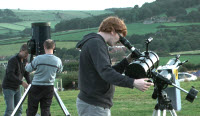
Mark, John and Lee at the scenic
Camp Site (photo by Keith)
A week before this event most of the weather forecasting sites were predicting overcast skies for August 30th, a little disheartening, so it was under almost crystal clear skies that society members journeyed in convoy (sort of) over to Robin Hood’s Bay for the annual Hook’s House Star Party!
Even the breeze had abated somewhat – so under almost ideal conditions seven scopes were deployed on the play field – more than enough for happy campers and members alike.

Astophotogapher Warren,
warming-up (photo by Keith)
First up on the observing menu was a lovely crescent moon, sinking slowly down towards the west horizon. With clear views to the SW hopes were high of catching Saturn and Mars before they set. We were not disappointed, and although not at its best views of Saturn in particular caused a wave of excitement which spread round the campsite, more and more came along to look and marvel.
It was interesting to note both Mars and its rival Antares both just above the horizon. Mars blinked first and departed.
So after an hectic initial hour, moon and bright planets were memories - time for some deep sky wonders and quiche!
The site may not be über dark, but compared to the West Cliff it’s like being on a field overlooking a Bay – without lights- in other words it’s just terrific.
It wasn’t long therefore before the Milky Way was quite clearly visible in all of its glory, as well as a tray of very tasty sausage rolls. The Ring nebula, Dumbbell, M13, M92, M81 & 82, M18, M21, M22, M56, M15 and double cluster were all superb, not forgetting M31 and tomato soup.
Several meteors graced the sky, one in particular was rather impressive shooting down toward the SE horizon. Mark gave various laser tours, attracting blue lights and a helicopter, complete with search light, but we think this was a coincidence?
So, a great site, a great sky, a great audience, a great feast- what’s not to like!
Mark – well i did miss the hotdogs, otherwise nothing at all.
Thanks to Andi, John, Keith, Lee and Warren - nice quiche and sausage rolls.
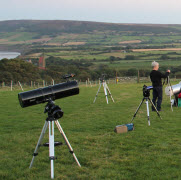 |
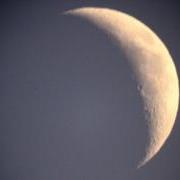 |
|
Setting-up at Hooks House Farm. (Photo by John Lamb) Click thumbnail for full-size image. |
Moon, taken at Hooks House Farm Star Party. (Photo by John Lamb) Click thumbnail for full-size image. |
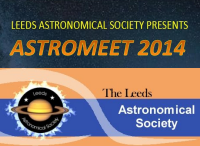 This year’s Astromeet is on Saturday 8th Nov. The venue as usual is the Clothworkers Hall and Foyer, School of Music, Leeds University. Doors open at 9.00am with talks from 10.00am to approx 4.30pm. Traders and some astro-organisations will be present.
This year’s Astromeet is on Saturday 8th Nov. The venue as usual is the Clothworkers Hall and Foyer, School of Music, Leeds University. Doors open at 9.00am with talks from 10.00am to approx 4.30pm. Traders and some astro-organisations will be present.
WDAS Members will be travelling in a number vehicles leaving from the Whitby School Car Park at 08:00h. If you'd like to attend please let Mark know to make sure of a place.
Ticket cost: £10 at the door, reduced to £5 for under-16s and full time students on presentation of a valid student card.
Confirmed Speakers
|
10:00h |
Prof Albert Zijlstra ‘The formation of planetary nebulae’ |
 |
|
11:35h |
Prof Lionel Wilson ‘Vesta- the key to early asteroid history’ |
 |
|
13:45h |
Dr Carolin Crawford ‘When galaxies collide’ |
 |
|
15:20h |
Dr Allan Chapman ‘Edmond Halley: astronomer, geophysicist and sea captain’ |
 |
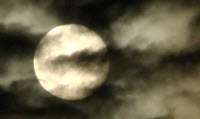 After August’s full moon wash out, would September’s fare any better?
After August’s full moon wash out, would September’s fare any better?
Initially things looked promising and we would get to view thmoon rising over the east horizon. However it became evident that by the time of moonrise, cloud in the wrong place was going to spoil the party.
Society and members of the public alike gathered around Cpt Cooks statue passing the time by trying to estimate/gauge just where the moon might appear. And then ... ta da, the moon appeared in a clear slot several degrees further out to sea from where estimated. Cue a frenzy of scope and camera activity, five minutes later it was gone again, just as Mark had a scope aligned.
Defeated again - well not quite because clouds did finally clear out of the way later on, allowing plenty of time to take some shots, Unfortunately by then any dramatic impact had been somewhat diluted with the moon higher in the sky.
The following night mark and several other members did independently take some images of the moon rising. Verdict:
Astronomers 1 - Grumpy Mother Nature 1.
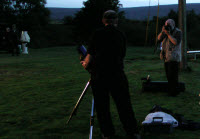 After a predominantly overcast day, and some pessimism about prospects of being able to view anything outside, wouldn't you know it, skies cleared as forecast and remained clear for the duration of the event at Westerdale, making our journey very much worthwhile.
After a predominantly overcast day, and some pessimism about prospects of being able to view anything outside, wouldn't you know it, skies cleared as forecast and remained clear for the duration of the event at Westerdale, making our journey very much worthwhile.
The sky was quite magnificent from the venue of the village hall car park. Quite a posse of members made it with just the one navigational miscalculation, although I believe Warren enjoyed the very scenic route.
After a difficult year it was good to meet up again with our resident Westerdale member and good friend John Randles especially after not seeing him for a while. No need for any indoor presentation this year, scopes were set up straight away, a total of six in all!
Apart from our usual ‘summer/autumn’ sky collection, several meteors were also spotted, to the delight of all. A laser point sky tour illuminated the menagerie of constellations visible in the late summer sky.
Views of the rising last Qtr moon flagged up the end of the event, which was enjoyed by all present. On cue, the starry sky was snuffed out by cloud on our journey home.
Verdict: Astronomers 2 - Grumpy Mother Nature 0.
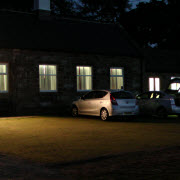 |
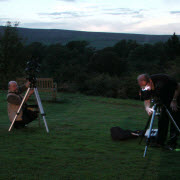 |
|
Arrival in Westerdale (Photo by Andi) Click thumbnail for full-size image. |
Keith and John set up at Westerdale. (Photo by Andi) Click thumbnail for full-size image. |
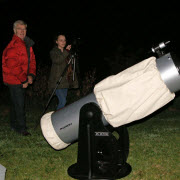 |
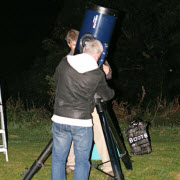 |
|
Warren and granddaughter in Westerdale (Photo by Keith) Click thumbnail for full-size image. |
Mark and Andi steadying the big Meade at Westerdale. (Photo by Keith) Click thumbnail for full-size image. |
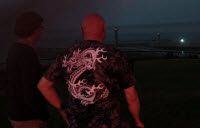 The final scheduled event of the summer (Sept. 20th) fell victim to quite unseasonably chilly and blustery conditions, with cloud scudding in off the sea, not really conducive for public viewing.
The final scheduled event of the summer (Sept. 20th) fell victim to quite unseasonably chilly and blustery conditions, with cloud scudding in off the sea, not really conducive for public viewing.
A week later summer had returned and an unscheduled event took place on the 27th. Warm, clearing, transparent skies and benign conditions ensured really good ‘seeing’ for the coast, so objects appeared rather steadier than usual, impressing a steady stream of interested onlookers. Setting up for 6:45pm (which seemed a little odd) to hopefully catch a setting crescent moon, didn't quite go to plan as the moon was hidden by the Royal hotel. You can’t win them all.
Still it was an enjoyable evening and as cloud increased by 9:30 we called it a night.
Sky Notes
In this month's Sky Notes:
- Planetary Skylights
- Comet C/2013A1 Siding Spring passes Mars
- Meteor Activity
- October 2014 Sky Charts
Planetary Skylights

 Mars and Saturn just about remain on view, very low in the WSW evening twilight sky, becoming increasingly difficult to spot if your horizon is cluttered. Saturn is lost by the end of the month, whilst Mars lingers, slowly sinking down toward the SW horizon.
Mars and Saturn just about remain on view, very low in the WSW evening twilight sky, becoming increasingly difficult to spot if your horizon is cluttered. Saturn is lost by the end of the month, whilst Mars lingers, slowly sinking down toward the SW horizon.
 Comet C/2013A1 Siding Spring, a binocular object, lies very close to Mars on the 19th (7:30pm). The moon lies nearby Mars on the 28th and Saturn on the 25th.
Comet C/2013A1 Siding Spring, a binocular object, lies very close to Mars on the 19th (7:30pm). The moon lies nearby Mars on the 28th and Saturn on the 25th.

 Uranus comes to opposition on the 7th and hence is due south at midnight. Neptune is visible in a telescope and lies near Sigma Aqr.
Uranus comes to opposition on the 7th and hence is due south at midnight. Neptune is visible in a telescope and lies near Sigma Aqr.
 Jupiter is a bright object in the dawn sky, moving into Leo by the month’s end. The moon is nearby on Oct 18th.
Jupiter is a bright object in the dawn sky, moving into Leo by the month’s end. The moon is nearby on Oct 18th.
 Mercury pops into the dawn sky during the final week of Oct and into November for its best morning apparition of the year. Look for it 30 minutes before sunrise (around 6am GMT) a few degrees above the east horizon.
Mercury pops into the dawn sky during the final week of Oct and into November for its best morning apparition of the year. Look for it 30 minutes before sunrise (around 6am GMT) a few degrees above the east horizon.
Comet C/2013A1 Siding Spring Passes Mars
Discovered in Jan 2013, comet Siding Spring is a comet from the Oort cloud, a giant swarm of debris chunks left over after the formation of the solar system which resides some 5000-100,000 AU from the Sun.
Containing up to 2 trillion chunks, this particular Oort fragment will pass exceptionally close to Mars on the 19th, skimming just 132,000 km above the red planet’s surface. At mag +8.3 the comet should be an easy binocular target, though will be better seen in a short focal length scope just a few arc minutes from Mars.
As astronomical twilight exists by 19:45h look from 19:30h. Viewing will be a bit of a challenge as Mars will only be five degrees above the SW horizon.
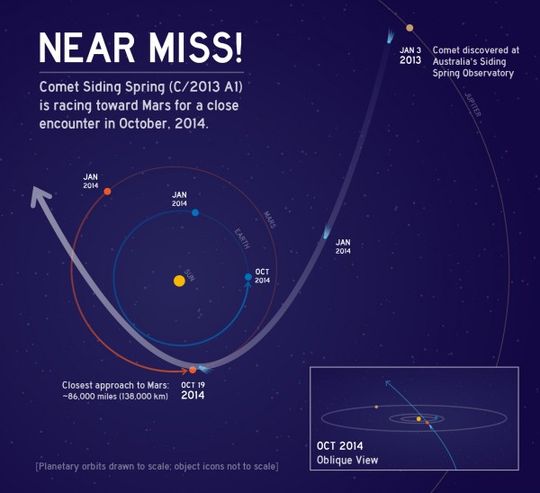
Meteor Activity

There are no less than three meteory showers to tempt you outside on October nights:
- The Orionids (Oct 16- 27) are the months most reliable shower, peaking on the 21st with hourly rates approaching 25. Like May’s Eta Aquarids, Orionids are associated with Comet Halley, but are more favourable for northern hemisphere observers due to the radiant being situated high in the S by early morning hours. Orionids are swift, often producing persistent trains. With the moon just a couple of days off New, this year offers an excellent opportunity to catch some shooting stars - especially in the early dawn sky.
- The weak Piscid shower has three peak dates, Oct 13th being the optimum one. Observed rates are little better than sporadic levels - around 3-7 per hour. Piscid meteors are often slow, of long duration, but not very brilliant.
- Perhaps the most interesting shower is the Giacobinids or Draconids (Oct 6 -10th peaking on the 8th) which are associated with the periodic comet Giacabini- Zinner (6yrs) The shower is very erratic, but can produce outbursts of activity so keep an eye open, particularly on the 6th. Early morning viewing will be the optimum time.
September 2014 Sky Charts
Click each image to see a full-size Sky Chart:
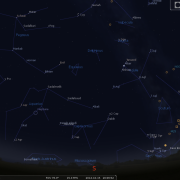 |
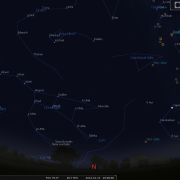 |
| Looking South Mid October-20:00h |
Looking North |
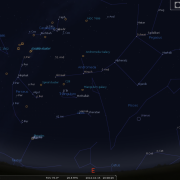 |
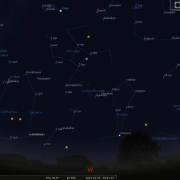 |
| Looking East Mid October-20:00h |
Looking West Mid October-19:45h |
Image Credits:
- Planets and Comet Chart: NASA
- Sky Charts: Stellarium Software
Events
 Observe the night sky with us at the Bruce Observatory, Whitby School
Observe the night sky with us at the Bruce Observatory, Whitby School
Observing Nights are held weather permitting: check for a relatively clear sky before leaving home. If in doubt, Mark can be reached on 07886069339
Please note the college drive gate is now operated via a electronic key code - so anyone wishing to attend must be at the car park at the top of the drive by 19:00hrs - unless an arrival time has been arranged with Mark/Keith.
 Whitby School - Room H1.
Whitby School - Room H1.
In Members' monthly meetings we usually take a tour of the night sky for the coming month using the Planetarium program. Have talks and presentations on various topics of astronomy/space etc, and discuss future events etc. New members welcome.

